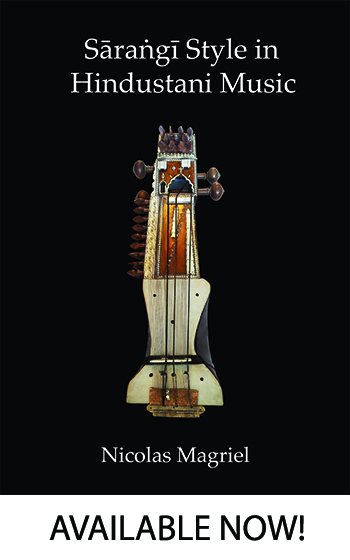The Sarangi
The sarangi (सारंगी) is the quintessential bowed instrument of South Asian art music. Its name is widely believed to mean "a hundred colours" suggesting its adaptability to a wide range of musical styles, its flexible pitch, and its ability to produce a large palette of tonal colour and rich emotional nuance.
The sarangi is revered for its uncanny capacity to imitate the timbre and inflections of the human voice as well as for the intensity of emotional expression to which it lends itself. In the words of Sir Yehudi Menuhin: "The sarangi remains not only the authentic and original Indian bowed stringed instrument but the one which... expresses the very soul of Indian feeling and thought."
Nicolas Magriel
Nicolas Magriel has been playing the sarangi since 1970. He has spent around twelve years in India studying the sarangi and Hindustani vocal music and also doing research on Indian music. During the 1980s he performed widely in Britain and in Europe both as a soloist and as an accompanist to Hindustani vocal music and kathak dance.
His sarangi can be heard on several film and television soundtracks including The Jewel in the Crown, End of Empire and The Great Gatsby. He has collaborated with pop musicians including George Harrison, Voice of the Beehive, the Suns of Arqa, the Bangles, and Take That. Having completed his PhD on sarangi style at the University of London in 2001, much of the new millenium has been spent on two AHRC-funded research projects, The songs of Khayal, an in-depth two-volume study of Hindustani vocal compositions, and Growing into Music for which he produced seven films on musical enculturation in Hindustani, Rajasthani and Qawwali traditions. His definitive work on all things sarangi, Sarangi Style in Hindustani Music ,was published in 2021, and a South-Asian edition is forthcoming.
Sarangi.net
This website is a redesigned and expanded version of "Nicolas Magriel's Sarangi Site" which I created rather idiosyncratically in 1997 during the internet's early days. The site became an archival treasure chest in 2014, and it has now been modernised and rebuilt in 2024. Sarangi.net is dedicated to the sarangi and the many sarangi players whom I have had the good fortune to know. On this site you can find:
1) a mammoth archive documenting over a hundred sarangi players whom I worked with when doing my PhD research in India in the nineties. This includes biographical and anecdotal information, but most importantly, videos and audio. As of March 25, 2015 there were 300 videos of 52 sarangi players on the site as well as some rare audio of great sarangiyas of the 20th century. As of October 2024, there are now more than 700 videos populating the site.
2) information about the sarangi, its history and social significance, its construction, maintenance and repair, and its technique.



